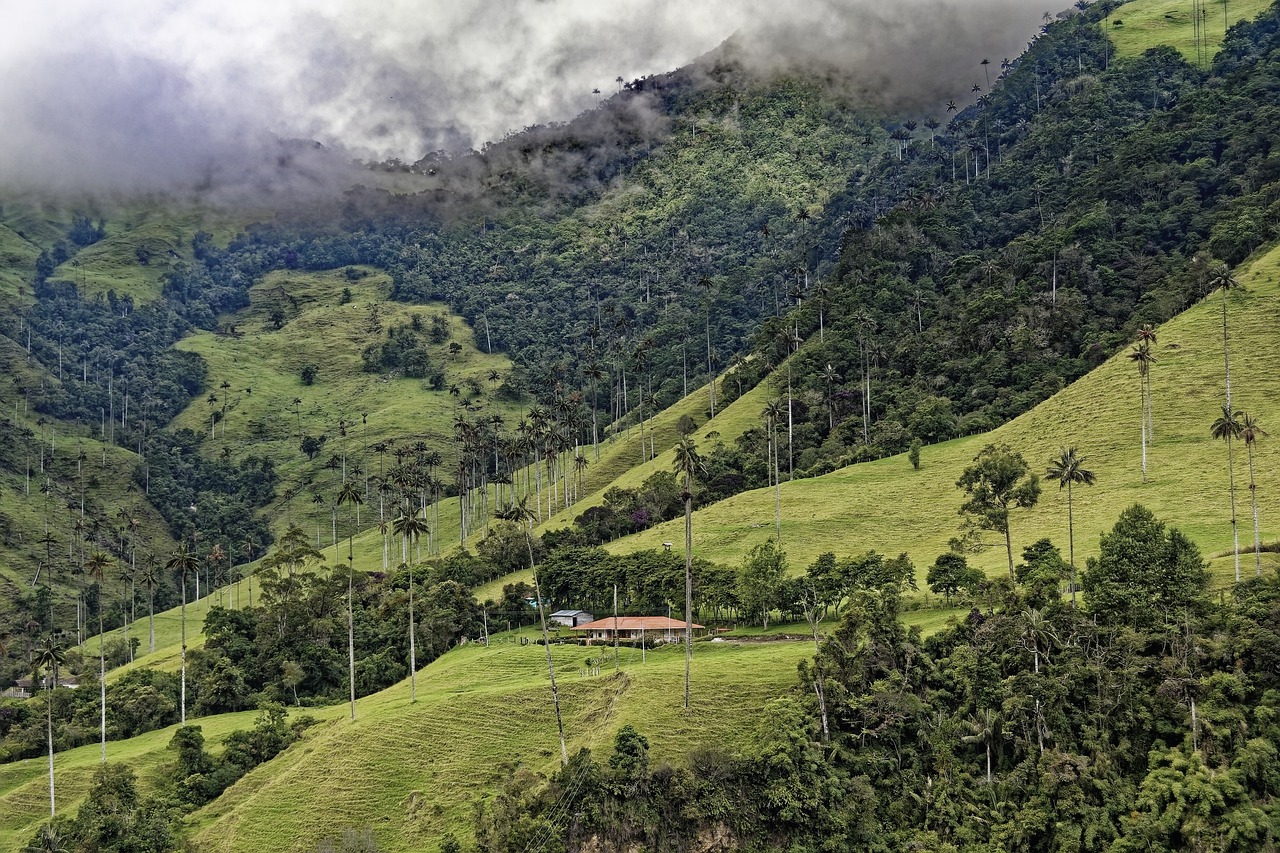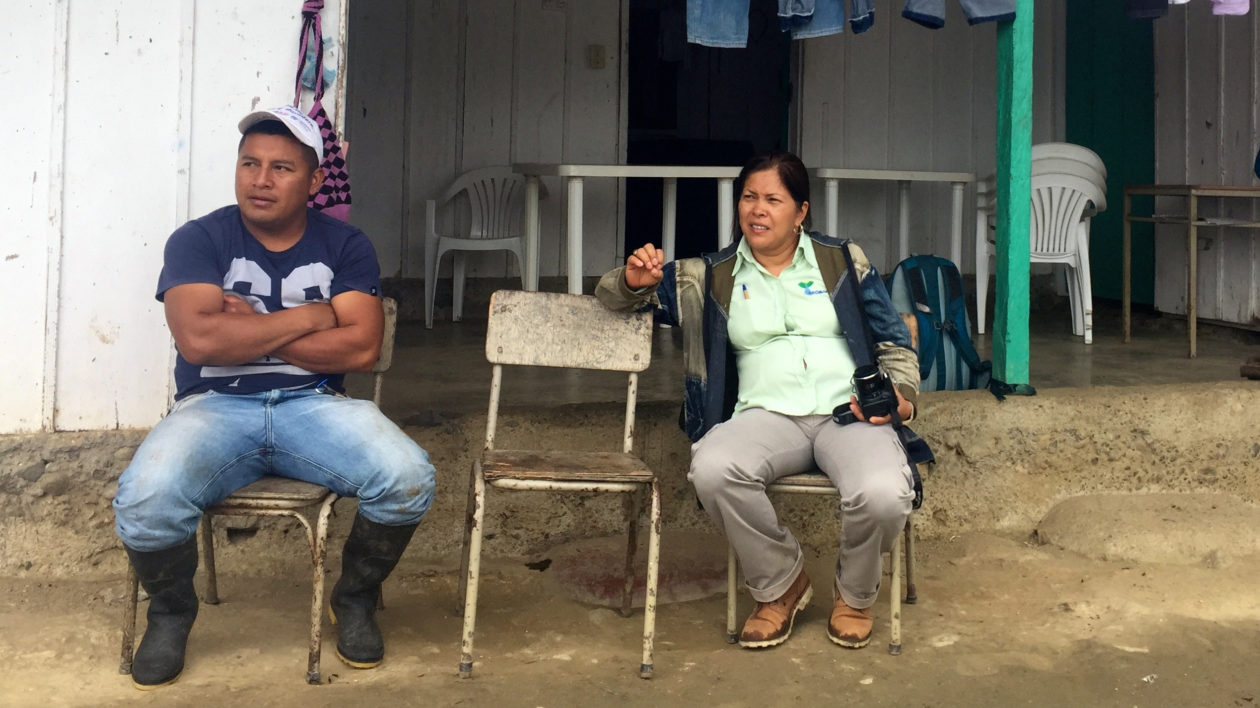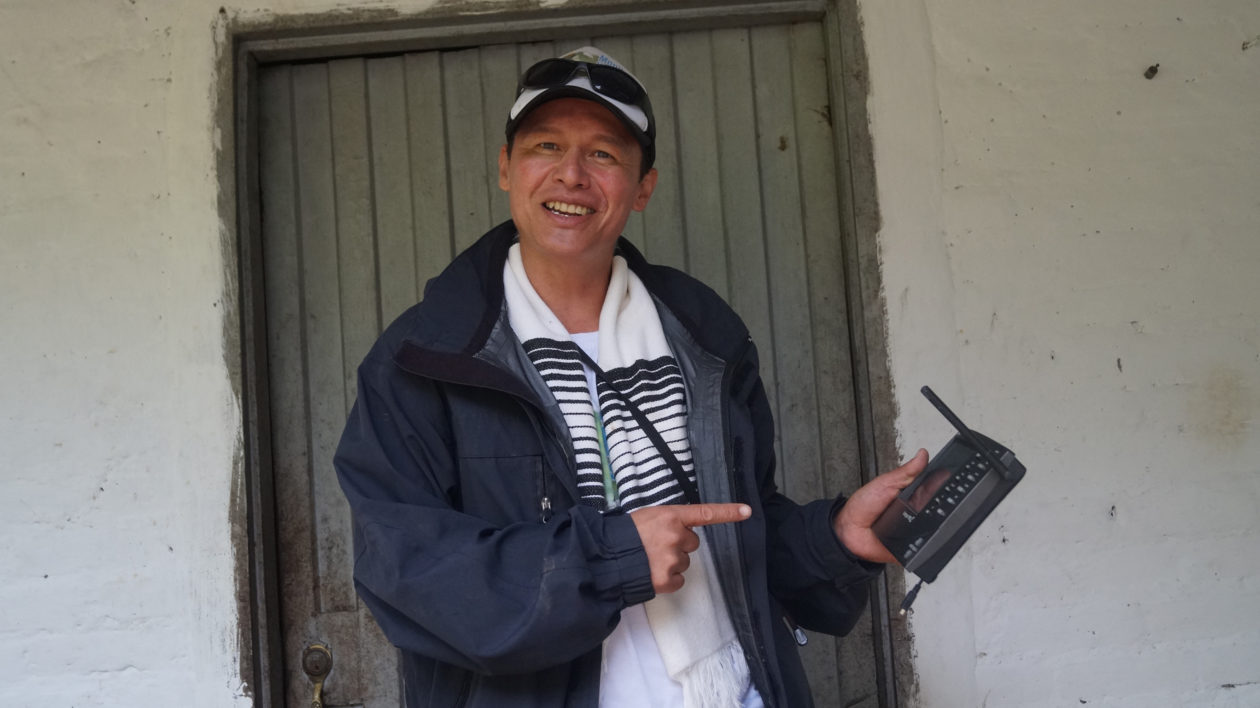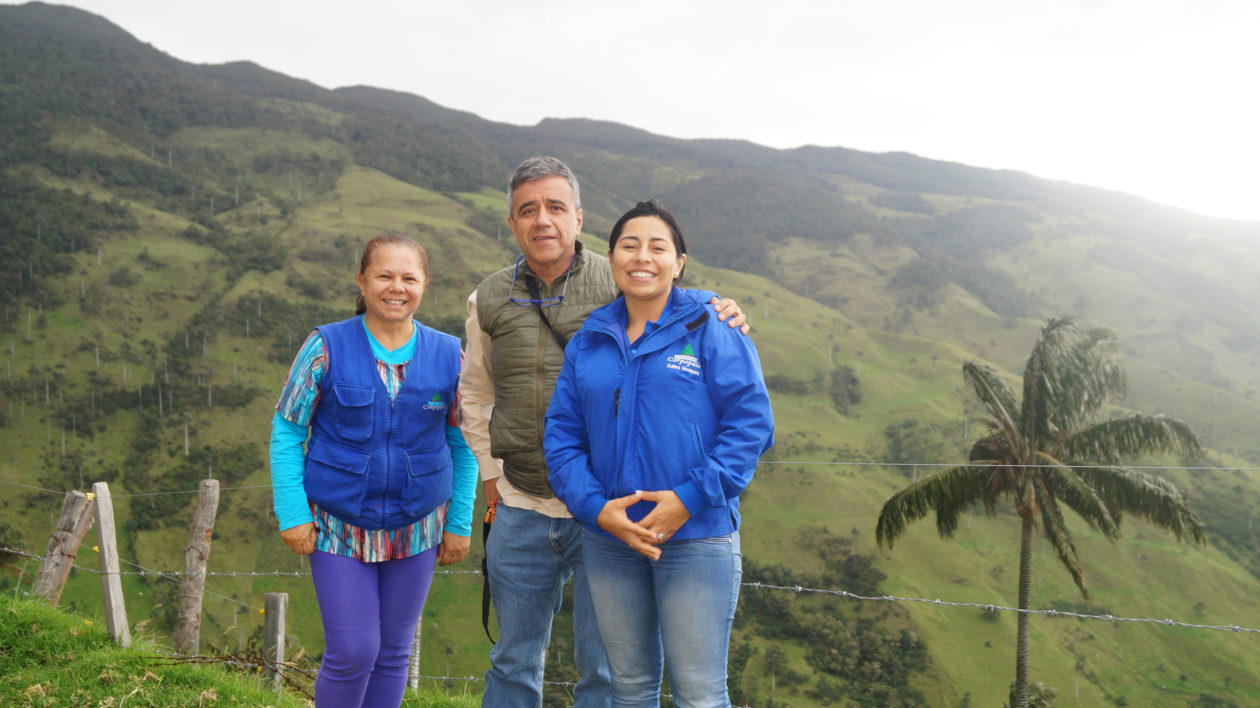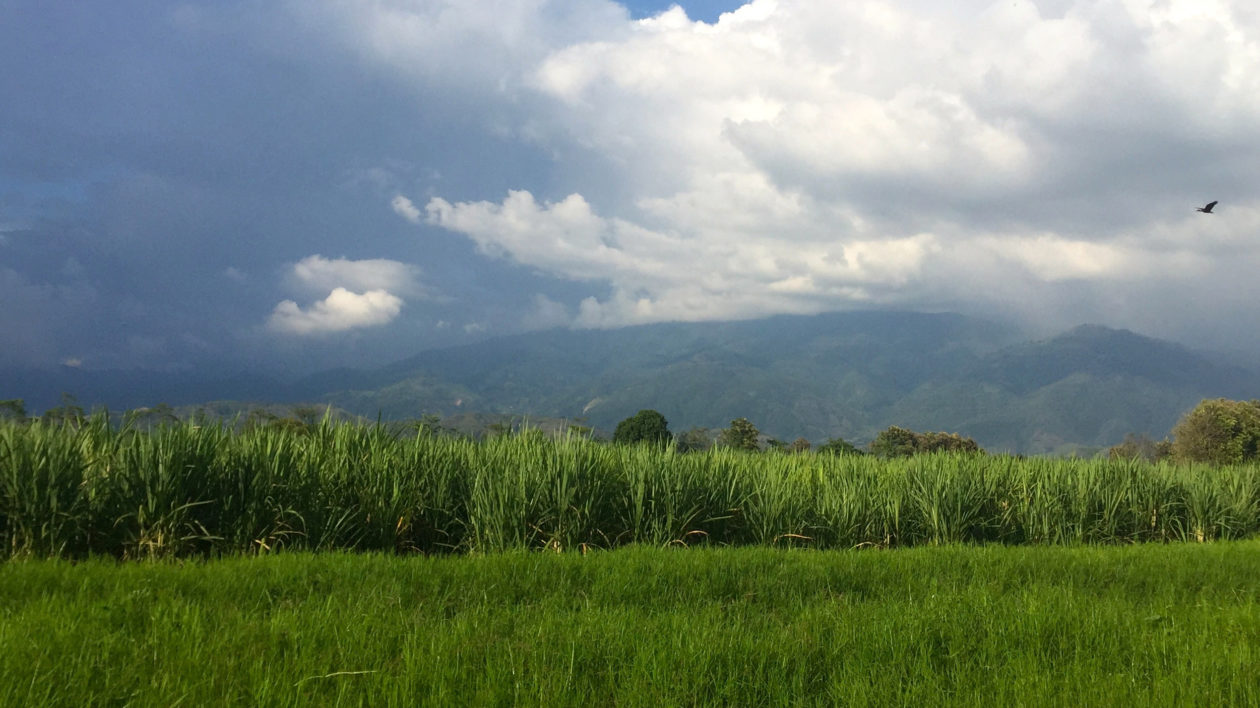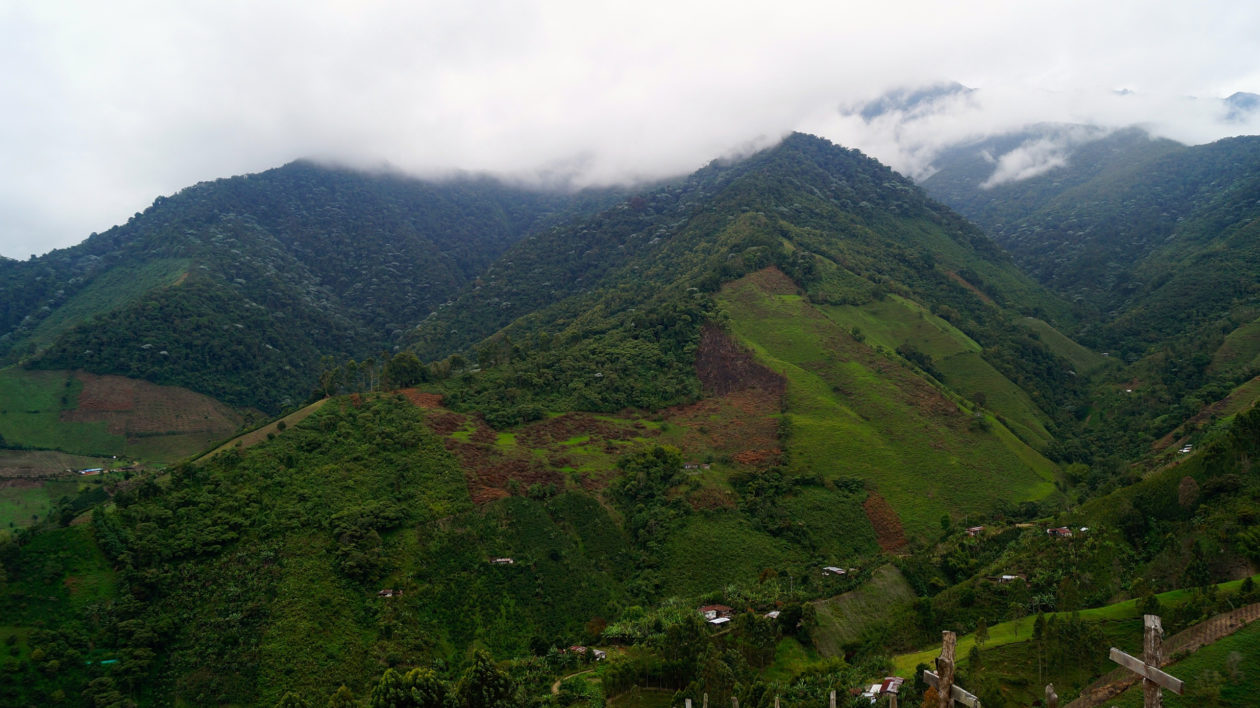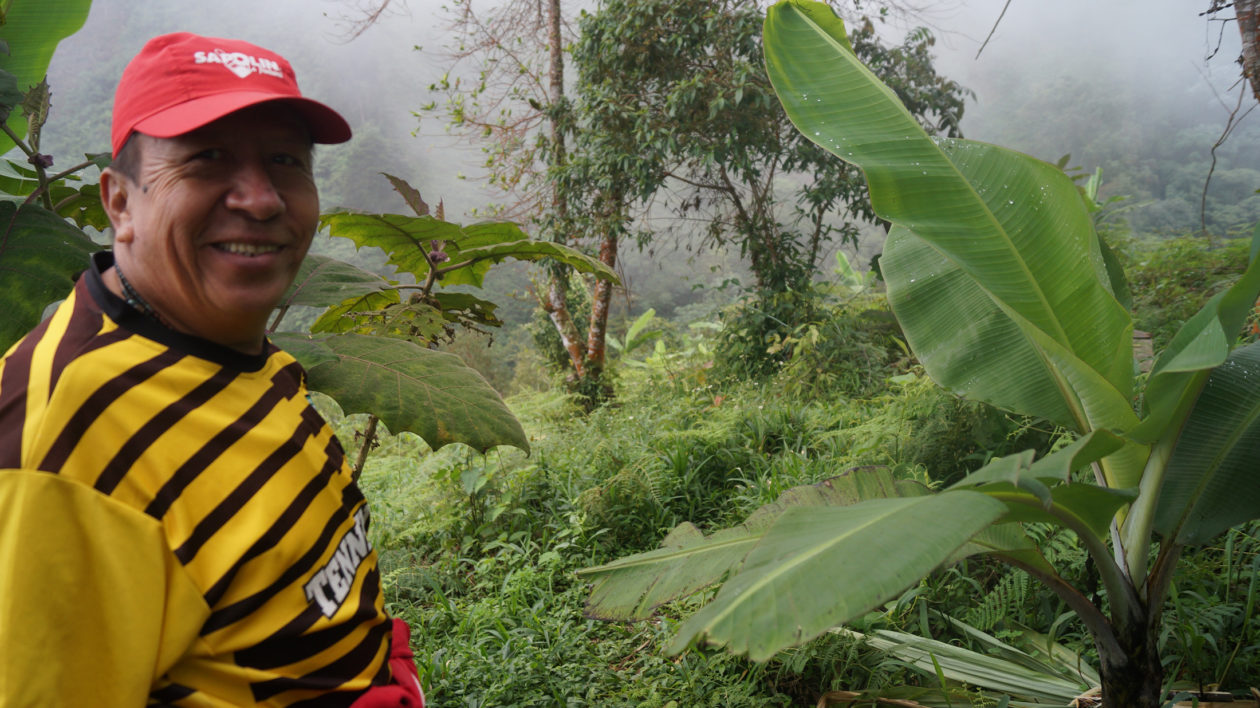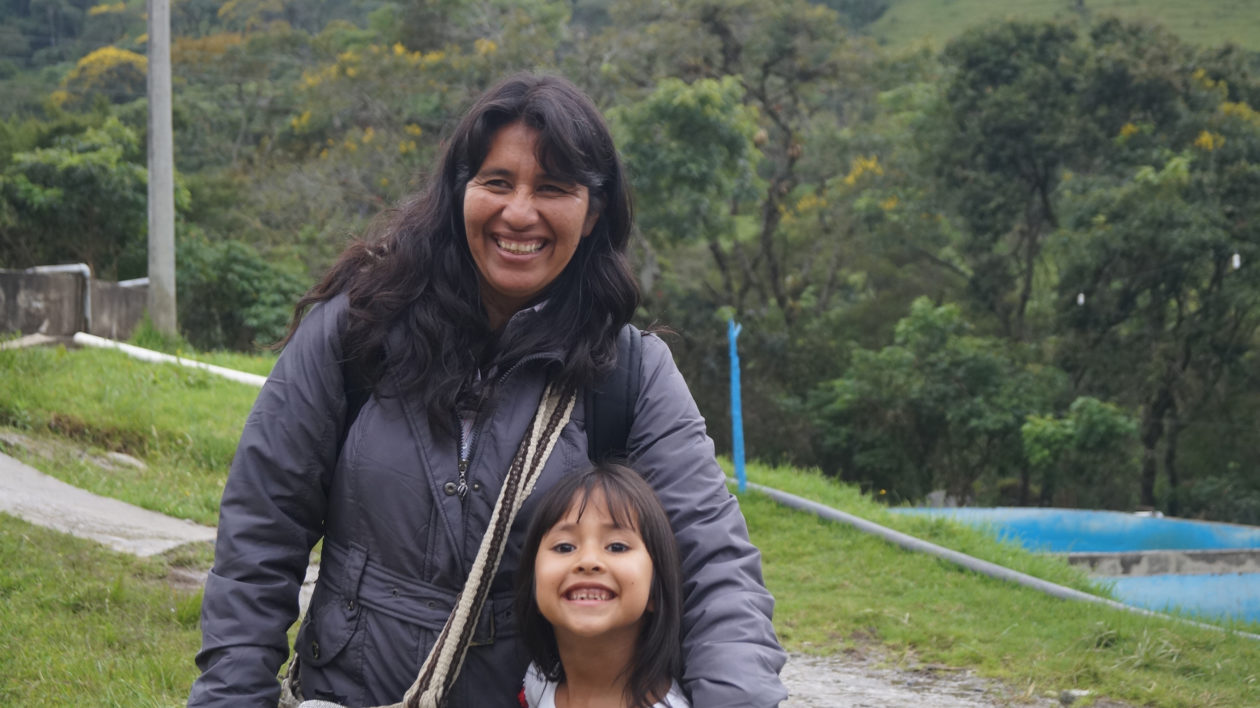As part of the MRI's mission to promote global change mountain research, we are excited to bring visibility to the six projects that form the Belmont Forum’s ‘Mountains as Sentinels of Change’ program by highlighting a different one each month.
What are the key factors that enabled a successful water fund in Colombia to work with over 1000 families to protect more than 2000 km of streams and conserve or restore nearly 10,000 ha of forest – even in the broader context of armed conflict and widespread distrust? This month's featured project from the Belmont Forum's 'Mountains as Sentinels of Change' program is ClimateWIse. Read this blog post – first published on The Nature Conservancy's 'Cool Green Science' website – for a glimpse into their activities.
Seven Things We Learned by Listening to Those Who Make Water Funds Happen
Written by Leah Bremer & Kelly Meza Prado, ClimateWIse.
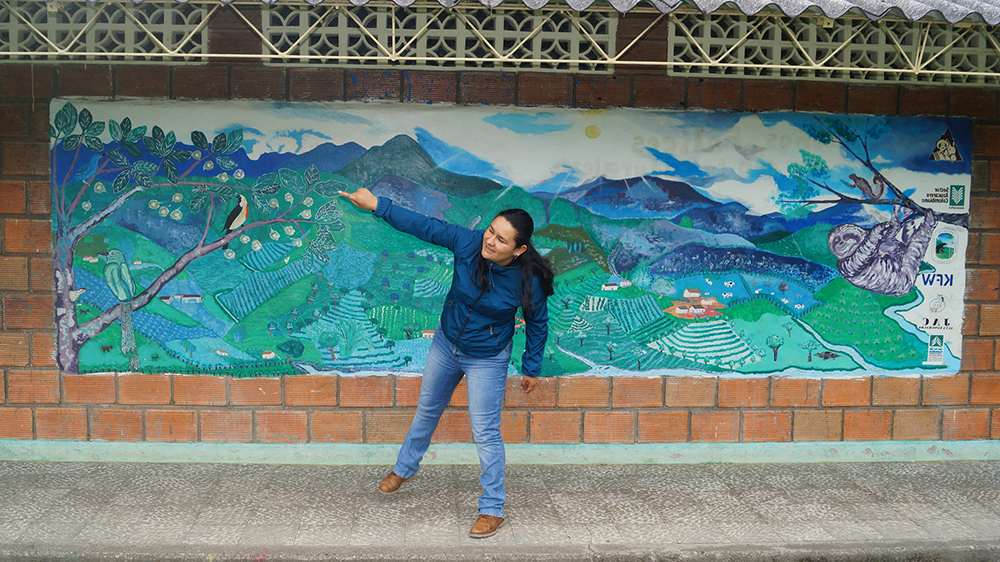
Cristina Jaramillo shows us a mural created by a local school highlighting the diverse biological resources of the area where she grew up. Photo © Leah Bremer
“Caña, caña, caña” – “Sugarcane, sugarcane, sugarcane,” Pedro Moreno lightly chants. Pedro, the technical director of the water fund Fondo Agua por La Vida y La Sostenibilidad (Water Fund for Life and Sustainability; FAVPS), is driving us through what feels like endless fields of sugarcane spanning the fertile lowlands of the Valle de Cauca and Cauca Departments. Our gaze shifts towards the fog covered highlands, where river user associations and other local organizations have worked with local landowners and communities for over 20 years to protect and restore the regions’ 26 source watersheds. Since 2009, FAVPS has helped connect and strengthen these local organizations, and Pedro and others emphasize that without relationships, connections, and trust established over many years, there would be no water fund.
This is my sixth time visiting FAVPS. I have worked with the water fund, Cenicaña, Asobolo, and the Nature Conservancy to develop hydrological and socio-economic monitoring as a post-doctoral researcher with The Natural Capital Project. This time, I return with my colleague, Kelly Meza Prado, on a mission to listen to the people and communities that make up the multi-layered social-ecological fabric of this water fund. We want to understand how and why this water fund has been able to work with over 1000 families to protect over 2000 km of streams and conserve or restore nearly 10,000 ha of forest.
Here are seven ingredients of success that we learned by listening:
1. Local community-based organizations are the “jewel in the crown,” and the relationships they build take time.
Amalia relaxes with community leader of the Nasa community who she has worked to build trust with for many years. Photo © Leah Bremer
This water fund’s unique story started during Colombia’s internal armed conflict. We asked everyone we talked to what key factors enabled this water fund to begin, grow, and involve so many people, even under periods of intense conflict and widespread distrust. The answer was always simply “las asociaciones” (the local river user associations). One sugar cane representative called them “la joya de la coroña” – the jewel in the crown.
Amalia Vargas Morales, the director of the river association of the Bolo watershed—Asobolo—has worked with communities and farmers in the area since 1992. As we tour through the dirt roads connecting the indigenous communities, small and large farms, and local schools that she works with, the trust she has built is palpable. As we drive the winding roads, many people wave at Amalia through the window, stop her to greet her and ask her work-related questions, and some even wait for her with “tinto” (coffee) and pastries for breakfast. These are not short-term relationships. These are long-term relationships, some built over 20 years of constant engagement. But that can be broken in a day, she tells us. To involve people in the water fund, there really are no short cuts. In rural areas like this, building trust and relationships between local organizations and communities takes time, but it is a key ingredient of success in any water fund.
2. Hiring people from the community is more than a co-benefit, it’s another key ingredient of success.
An example of the power of local staff — Baudelino of the Buitrera region, an employee of Cenicaña, has led the water funds’ successful monitoring program in the Bolo watershed. Photo © Leah Bremer
An unsung potential benefit of water funds lies in the potential to generate employment and enhance local capacity around sustainable management. FAVPS’ work spans three Colombian provinces. At the opposite end of fund from the Bolo watershed, in the Risaralda province, I tour the steep slopes of Santuario, a small town below the Esmeralda micro-watershed with program manager Cristina Jaramillo. Cristina was born and raised here, and she describes her deep love and passion for “el campo” – rural areas.
The writer Aurelio Arturo describes this region—designated as a UNESCO world heritage site for the coffee culture—as a land “of all the colors of green.” The highlighter green ‘árbol loco’ (crazy tree), planted as part of the FAVPS project to serve as a living fence, stands out against darker forest species. Coffee and banana dot the slopes with even more shades of green. Cristina’s work is funded not just by the coffee sector but also by the water fund, as the Esmeralda microwatershed provides water to sugar cane downstream. This project is much newer than the river associations, dating only to 2013, but Cristina and her colleague Noberto have already successfully engaged with and enrolled 72 of 75 farmers in an ecological corridor restoration project.
We end our afternoon tour sipping ‘tinto’ at Cristina’s house with her parents. When I ask others why this project has been able to work with so many families, to build trust over a relatively short time, the answer is always ‘Cristina’ – someone known and trusted by people because she is from there. While building trust still takes time, putting people from the communities where water funds work into key leadership positions is critical.
3. Deep local participation and ownership matters.
From left to right: Patricia, Pedro, and Dulima point out the drastic increase in forest cover in the headwaters of the Palo watershed since 2010 in line with the community’s vision. Photo © Leah Bremer
In the headwaters of the Palo watershed in between Bolo and Esmeralda, Dulima Mosquera, the leader of CorpoPalo, the local river-user association, and her colleague Patricia Pietro invite us to visit an indigenous Nasa community with whom they work. CorpoPalo has been working side-by-side with the Nasa community since 2010 to support projects defined by the community themselves. This includes improving cattle production through rotational grazing to reduce pressure on forest and páramo (the highland Andean grasslands) ecosystems. Community members participating in pasture management projects report doubling of milk production. But the real benefit people care about, says Dulima, is the ability to better protect their land or their “espacios de vida” (life spaces).
When I have a chance to interview Doña Nancy, the leader of these communities, I ask her why the community decided to work with CorpoPalo. “We have always been very skeptical of institutions,” she says. “They always come in and tell us what to do – this is part of long history of colonization where we were treated as sub-human, not capable of making our own plans.” CorpoPalo, she says, was different. They listened. Dulima asked what kind of land management the community wanted and worked alongside them to learn and make that happen. Doña Nancy tells me that if project ideas did not come from the community, they would never have long-term sustainability. They keep coming back and they keep listening, she tells me. I later mention this to Dulima, and she says, “yes, we listen because we admire them.”
Water funds by definition prioritize areas important for water, and they may use a variety of models and tools to select those areas. But, particularly in communities with deep cultural connections to their land, this prioritization must account for the interests of community members, the people who will ultimately be long-term stewards. Balancing prioritization for ‘downstream’ actors with activities that are designed and owned by ‘suppliers’ is a cutting-edge frontier for effective and sustainable water fund design.
4. Focusing on downstream benefits misses the real story.
Sugar cane in Valle de Cauca, with source watersheds in distance. Photo © Leah Bremer
In every conversation I have with Pedro Moreno, FAVPS technical director, he emphasizes that “you cannot have conservation with hunger.” He goes on to describe the importance of activities like agroforestry and silvopasture systems that boost economic production and contribute to food security in the region. In a water fund governing meeting we attended, a contributing member voiced similar thoughts about the importance of productive activities as the path to “starting conversations with communities.”
This is not an idea unique to participants upstream. I visited four sugar cane plantations during this visit and interviewed their respective representatives. Each echoed this idea. For them, the programs are about managing the watersheds for multiple benefits – a better regulated water cycle for sugar cane, yes, but also for communities and people living in the area. Far from simply being a way to implement natural infrastructure solutions to secure their own water supply, the sugar industry recognizes that their sustainability and social license to operate depends deeply on a safe and secure water supply for all.
5. This region is a hard place to do a water fund. It worked because of immense social resilience.
Shades of green in Santuario, Risaralda, where the water fund supports the Risaralda Coffee Committee to work with farmers to create an ecological corridor. Photo © Leah Bremer
This area was and continues to be intensely affected by Colombia’s 50-year-old armed conflict. Everyone has a story. Everyone. From living side-by-side with paramilitary who occupied a family’s farm for 6 years to losing a loved one to violence, the effects of the conflict—even as it has declined—are palpable. Yet, the people of this place are resilient. While many were displaced and left their farms, many others, indigenous communities in particular, stood their ground, organized, and protected their lands and ways of life. As we descend through the Palo watershed, we pass through a community-run checkpoint where the community patrols who enters and exits, holding their ‘batons,’ a sacred symbol of power and community solidarity. One indigenous leader described these ‘batons’ as more powerful than any weapon.
Through the conflict, the associations have worked in areas where they could. Some areas most critical for water supplies – like the páramo — have been off limits as central areas of conflict. With the conflict de-escalating and a signed peace agreement, people speak of increased opportunity to work in these areas. In the background of this opportunity is uncertainty, however. Will there really be peace? What new groups will emerge, and what will they do? How will re-population affect land use and water supplies? Despite this uncertainty, we find optimism and resilience.
6. A surprising component of climate resilience - increasing vegetation cover makes it a more refreshing area to live.
Local landowner and water fund champion Esteban explains how climate change affects banana cultivation along with the role of native species in keeping the area refreshing and beautiful. Photo © Leah Bremer
The temperature is rising, and el niño and la niña are occurring much more frequently than before. Everyone we talked with, in nearly every role, expressed this common sentiment. Esteban, a local farmer, explained the change in where he plants bananas – he can now grow them at higher elevations, an unexpected benefit of climate change.
The perception of climate change and its effects increased support for the water fund from both funders and upstream participants. While some talked about the benefits of conservation in terms of mitigating drought and flood, more commonly suppliers talked about the benefits of vegetation making the areas more “refreshing to live.” Refreshing is multi-faceted – cooler temperatures, more shade, more wildlife. While water funds will never change climate patterns, they are perceived to help maintain or even improve the quality of life in rural areas.
7. Water funds are about relationships – in an intricately linked ecological, hydrological, and social fabric.
Doña Nancy and her daughter, Linda Yu’ena in their ancestral lands. Photo © Leah Bremer
Two words I heard perhaps more than any other were ‘connections’ and ‘relationships.’ Connections between patches of forest for birds, a riparian corridor to protect a river, relationships between association directors, relationships between communities and their land. A watershed does more than connect water source to water user, it connects the lives of people who live within it and steward water resources for all.
When we talk about water funds, we talk a lot about scaling – how to increase the number of funds and how to increase the activities and influence within a fund. I learned you can’t scale without relationships between people or between people and their land. Even funding decisions, Pedro tells me, ultimately come down to one-on-one conversations and relationships.
A local scientist, Dr. Javier Carbonell of Cenicaña (Center for sugar cane research), explained his vision of scaling as an “efecto mariposa” – a butterfly effect. Successful projects built on strong relationships and trust are replicated, but sometimes through processes that are not immediately obvious. Cross-watershed, cross-region, cross-nation learning happens through networks and relationships, forming a global ecosystem. The work and relationships established in one place can inspire work in others. These connections are critical to the success and scaling of water funds in this region and beyond. They cannot be overlooked. We view our visit to the many mariposas of FAVPS as a first step in a broader effort to shine a light on the faces and relationships behind the people who “supply” ecosystem services and make water funds possible.
We thank Pedro Moreno and Kate Brauman for their helpful comments on this piece as well as the many Associations, organizations, and participants in Agua por La Vida who generously spent time with us and shared their insights and stories. We also thank NSF, coordinated by the Belmont Forum, for support of this work.
Cover image: Cristina Jaramillo shows us a mural created by a local school highlighting the diverse biological resources of the area where she grew up. Photo © Leah Bremer
About ClimateWIse
Compensating upstream residents to manage their land in beneficial ways is one way to improve downstream water resources. Projects like this, referred to as Investments in Watershed Services (IWS), are spreading rapidly in montane regions of South America. But the hydrology of changing landscapes in tropical mountains is understudied, as are the impacts of climate change.
ClimateWIse, a three-year project involving scientists from the University of Minnesota, the University of North Texas, the University of São Paulo, the University of Kassel, Germany, and the Natural Capital Project with support from the Belmont Forum through national funding agencies, evaluated whether IWS projects increase water quality and availability. To do so, the project used information and data from the Latin American Water Funds Partnership and the Brazilian Water Producer Program to measure and model impacts of land use and climate change on high-elevation páramo grasslands and Andean and Atlantic forests of South America.




